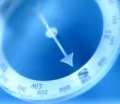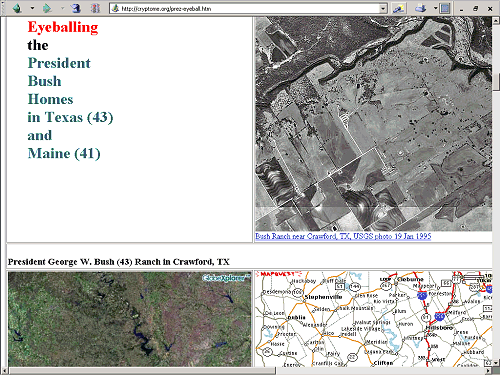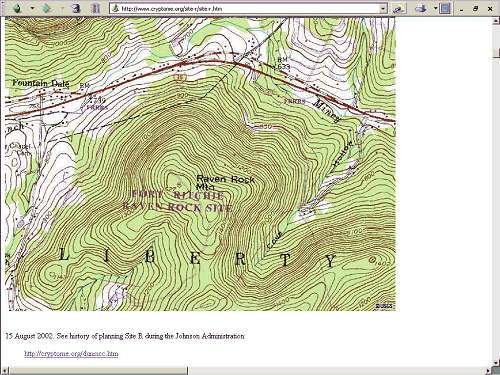
|
| Further Reading: » For more information about this subject, the following resources are recommended. [1] MapQuest; Terraserver. [2] Eyeballing of Cryptome, April 2002. [3] See for example, "Vice president in secure location at night", by John King, CNN, 11th September 2002. [4] Eyeballing a Chem-Bio War Target, 25th April 2002. [5] See Eyeballing US Transatlantic Cable Landings, 7th July 2002; Eyeballing US Transpacific Cable Landings, 8th July 2002; Eyeballing Downtown Manhattan Telephone Hubs, 10th July 2002. [6] The homepage of Natsios
Young Architects. Young’s partner Deborah Natsios maintains
the Cartome website [7] For an interesting discussion of development and application of technologies of aerial photography, satellite imaging, GIS and like see Mark Monmonier's book Spying with Maps: Surveillance Technologies and the Future of Privacy (University of Chicago Press, 2002). [8] Many secret and many other more mundane facilities are hidden underground. There is growing interest in so called 'urban speleology,' exploring man-made underground structures; see for example the Subterranea Britannica website. For more in-depth coverage see for example Anthony Clayton's Subterranean City (Phillimore & Co Ltd, 2000) and Nick McCamley's Cold War Secret Nuclear Bunkers (Pen & Sword, 2002). [9] The Guardian newspaper did a short piece on a few secret sites in Britain in 2000, linked to a story on the availability of the first national aerial photography map, the 'millennium map', of the UK. "The Russians spent decades getting hold of pictures like these. Now anyone can order them on the net", by Felicity Lawrence and Richard Norton-Taylor, The Guardian, 27th January 2000. [10] This issue is clearly illustrated in the "UK secret site photos ‘must go", BBC News Online, 7th June 2002. More information on 'chilling' effect on access to public information by governments and private business, see the Chilling Effects Clearinghouse. [11] Mark Monmonier, How to Lie with Maps, 2nd edition (University of Chicago Press, 1996). [12] More information on the influential work of Brian Harley on the radical re-interpretation of cartography, see The New Nature of Maps: Essays in the History of Cartography, edited by Paul Laxton (Johns Hopkins University Press, 2001). [13] For example see, Alexey V. Postnikov, "Maps for ordinary consumers versus maps for the military: double standards of map accuracy in Soviet cartography, 1917-1991", Cartography and Geographic Information Science, 2002, Vol. 29, No. 3, pages 243-260. [14] Website for the exhibition
and the accompanying book by April Carlucci and Peter Barber, Lie
of the Land: The Secret Life of Maps (The British Library,
2002).
|
| |
|
|||||||||||||||
| |
|
||||||||||||||
| |
Revealing Hidden Places: The Cryptome Eyeballing Map Series Maps can reveal hidden places that are beyond our sight. But they also have a unique power to deceive us by deliberately not revealing what is actually on the ground. Governments have many secret places, sensitive sites and critical infrastructures that they wish to remain hidden from prying eyes. The one government with the most to hide is undoubtedly the United States with its huge military and security apparatus, operating from innumerable bases and bunkers spread across the globe. Indeed, there is great fascination in contemporary culture - bordering on X-Files paranoiac obsession for some - with the activities of this military-industrial complex, and in particular with seeing what is behind the formidable fences and intimidating 'no entry' signs of its hidden places. The Eyeballing project <www.cryptome.org/eyeball.htm> developed by activist John Young uses publicly available maps to give a view into some of these secret and sensitive sites across America.
The project consists of series of individual 'eyeballing'
web pages, each of which focuses on a particular military base,
intelligence facility or other sensitive site, like nuclear power
plants and dams. Eyeballing exploits the potential of hypertext
to author a cartographic collage, piecing together a diverse range
of aerial photographs, topographic maps at different scales, photographs,
along with expert commentary by Young, annotated with corrections
and clarifications emailed in from (anonymous) readers. There are
also hyperlinks to supplementary documents and other relevant websites,
while individual eyeballs pages are themselves cross referenced
by hyperlinks. To produce the eyeballs Young only utilises public
sources of maps and imagery, typically topographic mapping from
MapQuest and aerial photography from Terraserver [1]. Even
though the 'eyeballs' have an unpolished, almost amateurish look
to them, the series represents a novel and valuable atlas of hidden
places.
Each eyeball spatialises a particular story of a hidden,
sensitive site, engaging with the reader to actively explore and
think what happens there. There are currently 172 individual
eyeballing web pages and the series continues to expand in numbers
and in its scope of subjects to map. So far the eyeballing series
has covered 11 airforce bases, 17 naval bases, the FBI, the CIA,
the National Security Agency (NSA), nerve gas storage facilities,
nuclear power plants, 54 dams, numerous little known intelligence
listening posts, as well as the Kennedy Space Centre, the Statue
of Liberty, and one particular family ranch in Crawford, Texas.
As well as the obvious sites, there are also some
unusual selections of eyeball targets that reveal the broad scope
of the project as well some of the idiosyncratic concerns of Young,
such as Las Vegas; He has even Eyeballed himself [2]. Much
of Young's interest is not with 'top secret' bunkers but with the
large number of facilities and infrastructures that are usually
obscured from public view and not really talked about. There is
still plenty more to do, of course, and he is working alone on the
project so it represents a considerable individual investment of
time and effort.
In a recent email interview, Map of the Month
asked John Young about the eyeballing project, focusing on his aims
and objectives in producing them. The project started in March 2002
as Young become intrigued by the continuing official ‘disappearance’
of the US Vice President Dick Cheney from post 9-11 Washington DC
to a secret bunker, which the media euphemistically reported as
a 'secure, undisclosed location' [3]. Young wanted "..to
locate the safe hole and publish it". The secure location
turned out to be a military command bunker, known as Site R, buried
under Raven Rock Mountain in rural Pennsylvania, close to Camp David.
This discovery provided the first eyeball
web page <http://cryptome.org/site-r.htm>,
a part of which is shown below.
Following on from the initial cartographic exposure of Site
R, Young eyeballed obvious, high profile, organisations like the
NSA, the FBI and the CIA, exposing their headquarters building complexes.
He also did a timely sequence looking at America's capacity
in terms of weapons of mass destruction in April 2002, eyeballing
probable storage of nerve gas [4]. The blurry and indistinct
views of these facilities in the remote deserts of Utah provide
a very pointed and potent reminder of the country in possession
of the most WMD. Young says that developing composites of multiple
sites, in order to expose "the extent of systems which cannot
be seen in a single facility has been a goal - as common among geographers."
The eyeballing of undersea cable systems and the telecommunications
hubs in New York City [5] are good examples of this.
Young is not a cartographer, instead he trained as an architect
and now runs a small practice in New York City with his partner
Deborah Natsios [6]. "As architects my wife and I
have long used maps and cartography in professional work",
according to Young, noting however, that this "has customarily
been quite local and limited compared to the eyeball series, and
none of our work has involved military facilities."
Young has a clear political agenda in creating the eyeballing
map montages, to show people the places that the powerful do not
want the rest of the community to know about or think about. The
mapping of facilities related to America’s continued maintenance
of weapons of mass destruction, for example, is clearly designed
to expose the hypocrisy of the Bush Government. Eyeballing is a
small and quite recent part of Young's activist work, dedicated
to exposing overbearing government and corporate secrecy, seeking
to reveal the murky workings of powerful organisations that wish
to operate hidden away from public scrutiny. He achieves this by
the unflinching disclosure of sensitive and controversial documents
via a unique information repository, an anti-secrecy library on
the Web, called Cryptome
<http://cryptome.org>, "which
has no limits and does not control its borrowed holdings",
says Young. The site has been online since 1996 and is an important
node in the realm of freedom of information, challenging powerful
interests particularly in the areas of surveillance technologies,
digital rights and cryptography. The Eyeballing project can be seen
as the subversive map room of the Cryptome library. Young has received
no official comment or complaint about the nature of his mapping
project thus far, but notes that eyeballing receives "quite
an impressive number of downloads from official websites, in particular
from the military".
"Maps are densely packed with information which helps
translate words into locations which may be visited either physically
or in the imagination" says Young. The Eyeballing pages
provide new vision that stimulates the imagination. They hint at
more than can actually be seen, making the viewer feel somehow illicit
in looking straight down onto some of the most secure and sensitive
places on the planet, such as the NSA headquarters. They give a
thrill at seeing something we are 'not meant to see' and yet the
maps themselves are entirely conventional, legal and publicly available.
This subversive feeling is created through the selection and then
unconventional arrangement of a specific set of maps. The matter-of-fact reality of the eyeball mapping actually helps to 'ground' some of these murky, anonymous and deliberately intimidating organisations. When we can see that they inhabit an ordinary office building, in a beltway sprawl of Washington DC for example, it begins to reel them into our everyday reality from the X-Files fringe, cartography dissolving their mystery. The eyeballs also give the audience a view that they could not normally get themselves, even if they wanted to. For most people it would be impossible to actually fly over the NSA complex in a plane.
The tactical exploitation of mapping in the eyeballing series
can also be read as placing the cartographic spotlight back onto
the powerful themselves, in a very small way of course. The best
mapping, in terms of accuracy and currency, has traditionally been
the exclusive preserve of the military, and the strategic advantages
this cartographic knowledge brings have been jealously guarded by
those in power. Indeed, much of the current mapping technologies
have military origins, most particularly for spying on enemies [7].
Yet, maps, even very detailed ones, can only tell us so much.
And Young himself is working within the constraints of freely available
public spatial data sources, which are often partial and out of
date. Consequently, the eyeballs he can produce only scratch the
surface of what is going on at these hidden and sensitive places.
We may snatch a glimpse of the buildings, roads and other visible
structures, but this is far from a panoptic view and grants the
reader little sense of the implications of what is being performed
daily at these sites. (Young's interpretative commentary does augment
the mapping to a significant amount.) The interconnections, flows
and chains of command, vital to the working of many hidden places,
cannot be observed in static maps of physical facilities. Aerial
photographs, topographic maps and satellite imagery can hint at
the nature of power, as materially expressed through the physical
structures, but they cannot actually show us power relationships.
Moreover, those organisations with something really worth
hiding have long been savvy to the watchful eyes above, putting
their most sensitive sites fully underground [8]. Maps showing
the access roads and entrance portals to such bunker complexes only
give the barest hint of their subterranean extent. Nowadays much
of the secret work of the military and intelligence community is
actually transacted in cyberspace, in the data networks, servers
and webs of classified information flows, which are again completely
invisible to conventional cartographic display of physical facilities.
Part of the wider of agenda of Young's Cryptome project is to try
to expose the actual workings of these virtual systems of security
and intelligence through publishing documentary evidence on their
structures, internal policies, statistics, budget details and other
banal, but revealing, administrative materials of the various organisations
involved.
Eyeballing has been made possible by the amount of detailed
spatial data, now publicly available on the Internet. These maps
are accessible and browsable to anyone online, through simple Web
interfaces. The fact that one does not require specialised knowledge
or software to use spatial data has greatly widened access. In recent
years a great deal of aerial photography and satellite imagery,
often from declassified military sources, as well as new commercial
satellite systems, has also become publicly available, although
the resolution and temporal scale of this imagery is still the poor
relation compared to what is produced by current classified military
systems. Clearly tensions may well arise between 'open skies' of
detailed commercially satellite imagery and the entrenched view
that the public should not know what is hidden behind walls and
fences.
Eyeballing demonstrates well the potential for novel applications
of spatial data, created by non-specialists, once it becomes easily
accessible, at least in an American context. It shows what can be
achieved in a quick, 'low-tech' fashion, by mixing and matching
publicly sourced maps and imagery. It would have been very much
harder to have created the eyeball web pages ten years ago for example,
particularly as a one-man effort.
However, it would certainly be a lot tougher to attempt
eyeballing outside the United States, as much of the rest of the
world is a long way behind the Americans in terms of access to detailed
spatial data freely available on the Internet, and quite often sensitive
sites, especially military facilities, are themselves censored from
published mapping. "It is frustrating to lack access to
eyeballing information outside the US like that available within",
commented Young, "the US centricity is distorting of what
information remains to be revealed about other countries."
There are hidden places and sensitive sites all over the world and
it would be interesting to see activists in other countries having
a go at mapping them [9]. "[W]e hope that the eyeball
series will induce other contributions of restricted and secret
mapping information from other countries as well as the US",
commented Young.
Yet, there are also worrying signs that the growth
in public availability of detailed spatial data may be coming to
a close. In the current ‘chilling’ atmosphere, of post
9-11 security paranoia, availability and easy access to whole rafts
of public information is being questioned. Spatial data, in particular,
can easily be portrayed as somehow especially 'sensitive' and of
likely value to terrorists [10]. The level of detail and
freedom of access to digital mapping and imagery enjoyed today,
may soon be locked away again, available only to 'authorised' users.
Young passionately says, "wider public access is under attack
by the secret keepers and should be fought vociferously".
All maps are distortions of reality, as they have
to be selective in what they show and do not show. Sometimes distortions
are imposed deliberately for overt purposes of propaganda or misinformation
and this works so well as people have an innate faith in maps as
truthful representations of reality. Mark Mommonier's book How
to Lie With Maps [11] nicely debunks the myth of cartographic
objectivity.
So
clearly, John Young's work in the eyeballs series only gives a pinhole
view into the world of hidden places, but it is a revealing view
nonetheless, and being freely distributed through the Web, it could
be argued that the eyeballs are potent maps of resistance to the
growing secret state, turning the tools of the watchers onto themselves.
Map of the Month asked Young about his 'dream' eyeballing
map, without current practical restrictions, and this is what he
said: "This would map surveillance systems of the world
and methods of hiding those by artfully camouflaging with public
disinformation."
|
||||||||||||||
| |
© 2003 Martin Dodge, Cyber-Geography Research |
||||||||||||||






